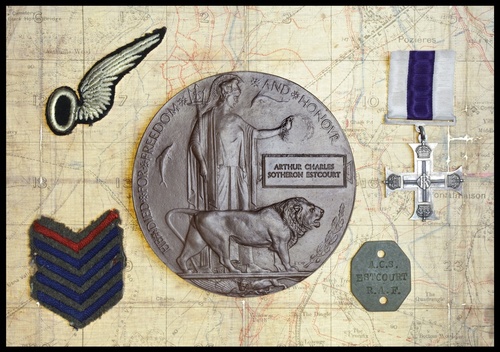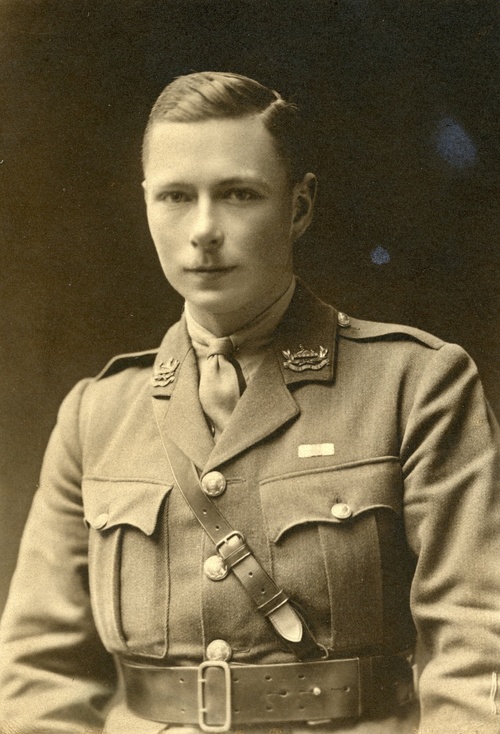Auction: 18001 - Orders, Decorations and Medals
Lot: 12
Sold by Order of a Direct Descendant
A well-documented and poignant Great War M.C. awarded to Lieutenant A. C. S. Estcourt, Royal Air Force, late Wiltshire Regiment and Royal Flying Corps
He was decorated for his gallantry at Le Boiselle on the Somme in early July 1916, when he was attached to a Trench Mortar Battery in support of the 8th Battalion, Gloucestershire Regiment: the nature of the fighting experienced by the Glosters on that occasion is reflected in the award of the V.C. to his C.O., Adrian Carton de Wiart
Estcourt was shot through the thigh by a sniper on 8 August 1916 and, on a later occasion, seriously injured by one of his own trench mortar rounds: notwithstanding his injuries, he gamely transferred to the Royal Flying Corps and was killed in action as an Observer in No. 5 Squadron on 8 August 1918
Military Cross, G.V.R., unnamed as issued, in its case of issue, together with the recipient's Memorial Plaque 1914-18 (Arthur Charles Sotheron Estcourt), in its original card sleeve and paper envelope, with Buckingham Palace condolence slip, together with O.H.M.S. postal envelope, addressed to the Rev. E. W. Estcourt, Milford-on-Sea, Hampshire, extremely fine (2)
M.C. London Gazette 26 September 1916:
'He fought his battery with great effect under very heavy fire during the attack, dispersing many enemy bombing parties. He also knocked out a machine-gun which was holding up the advance of one of our bombing parties.'
Arthur Charles Sotheron Estcourt was born on 26 September 1893, the youngest son of the Reverend E. W. Sotheron Estcourt of Estcourt, Gloucestershire, and rector of Long Newton, Wiltshire. Educated at St Aubyn's School, Rottingdean, followed by Gresham's, Norfolk, he went on to gain an open Mathematical Scholarship at Magdalene College, Cambridge, in January 1912. He was also awarded an exhibition by the Fishmonger's Company.
A member of the Cambridge O.T.C., he was commissioned into the Wiltshire Regiment in November 1914 and was ordered to France in late October 1915, where he was attached to the 8th Battalion, Gloucestershire Regiment. During the Somme offensive in the following year, he served in support of his unit in 57th Trench Mortar Battery, and it was for actions at La Boiselle that he was awarded his M.C.
Shortly afterwards, Estcourt received two bullet wounds in his thigh, one being a graze, the other more serious, and he was invalided home.
Returning to his Battery at the end of 1916, he was wounded in the face by the premature explosion of a bomb as it left the muzzle of a mortar.
Such was the serious nature of his injuries that he was not passed fit for duty until early 1918, when he opted to joined the Royal Flying Corps. Qualifying as an Observer, he was posted to No. 5 Squadron about the time of the commencement of the battle of Amiens. His flying career was short-lived, however, for his R.E. 8 was downed by enemy fire on 8 August 1918, and both he - and his pilot - were killed. His father received the following information:
'Your son with Lieutenant Robinson were in the second machine off the ground on the early morning of August 8th. They went up from the Amiens Drill Ground which I had temporarily made into an aerodrome. The weather was exceptionally bad which necessitated their flying very low and they were undoubtedly hit by machine-gun fire from the ground. The machine crashed near either Belfort or Beaucourt Wood, which is near Caix.'
Sold with an extensive array of original correspondence and other documentation, including:
(i)
Recommendations written by Captain P. G. Illingworth of 57 Trench Mortar Battery, for the Military Cross award to Estcourt, the first written in pencil on squared paper in the field, the second in flowing ink script: 'Lt. A. C. Sotheron-Estcourt, 8th Glouc. Regt. for most conspicuous gallantry on the 3rd and 5th July. Whilst in command of the Battery at La Boiselle, he directed the fire of the Battery with great accuracy from a very exposed position under heavy fire. It was entirely due to his great coolness that several enemy bombing parties were dispersed. He was responsible for putting out of action a machine-gun and its whole team which had been holding up the advance of one of our bombing parties. He also greatly distinguished himself at Bazentin-le-Petit'; together with original citation document, newspaper clippings regarding the Military Cross and congratulatory letter to his father from Major Charles H. Harding, Commanding Officer of the 8th Glosters, B.E.F., dated 28 August 1916: 'I must write to congratulate on your son getting the Military Cross. We are all so proud of it because we consider he really belongs to us. He did so well and thoroughly deserves it. I am sorry he is wounded, but I hear not badly. I hope you will soon have him home, we are in the trenches where he got wounded. Please remember me to all your family.'
(ii)
Post Office telegraph, dated 11 August 1916, informing the recipient's father that his son had been wounded in action: 'Lt. A. C. Sotheron Estcourt, Trench Mortar Battery, was wounded August 8th and admitted to 7 Stationary Hospital, Boulogne, August 8th, with gunshot wounds, thighs, condition satisfactory, Secretary War Office'; together with a letter dated 12.8.1916, from Estcourt to his father which details events: 'I was hit by a sniper on Monday afternoon in the trenches between Ypres and Armentieres - rather funny after being on the Somme since July 1st without being touched. The wounds are very simple. One went through the muscle of the left thigh and a graze on the right thigh.'
(iii)
Post Office telegraph dated 24.8.1917, informing his father of a second injury in the field involving his legs: 'Regret to inform you Capt. Arthur C. Southeron Estcourt was admitted No. 7 General Hospital St Omer, Aug. twenty second, with severe bomb wound, knees, accidentally, further reports sent when received, Secy. War Office.'
(iv)
Letter in pencil handwriting from Estcourt to his father dated 29 August 1917, 6pp., sent from No. 7 General Hospital, which details the healing of his wounds post-operation: 'There is nothing to be seen but a little slit about 3 inches long just above the knee cap - it has been sewn up and is healing up well.' It goes on to mention how strict the Sisters are in the hospitals now, before explaining the events which led to the wound: 'We were having a practise show in which our mortar had to fire for two minutes before the infantry attacked. We always use live bombs in these shows to make things a bit realistic. Towards the end of the second minute one of the bombs burst just as it left the muzzle of the mortar - due to a faulty fuze probably - it has happened many times before in other battalions, be we had so far escaped. One poor fellow who was just behind the mortar was killed outright and about ten were wounded.'
(v)
Letter from Estcourt to his father, dated 3.2.1918 and written at Maidstone, regarding his elation at being transferred to the Royal Flying Corps; a further letter in pencilled handwriting regarding his posting to No. 5 Squadron, and his early impressions of flying over the Western Front: 'I have been over twice now - it is so funny looking down at the trenches from a plane after being so used to watching planes overhead from the trenches.'
(vi)
Another letter to his father, written approximately 2 months into his R.A.F. posting in France, in which Estcourt discusses his daily life, including his hopes for leave, the food, and probable changes to R.A.F. uniform: 'Personally, I shouldn't be at all sorry to get out of khaki. I have been scanning the Country for 'wings' and have at last managed to get some - I feel quite an aviator!'
(vii)
A letter written by C. H. Gardner, dated 15 August 1918, explaining the circumstances of his death: 'He went out on patrol over the lines on the morning of 8th August with Lieut. A. D. Robinson. We do not know quite how they were brought down, but when found by us they were both dead. They were undoubtedly killed instantaneously'; another letter from Gardner, which provides more detail: 'Your son with Lieutenant Robinson were in the second machine off the ground on the early morning of August 8th. They went up from the Amiens Drill Ground which I had temporarily made into an aerodrome. The weather was exceptionally bad which necessitated their flying very low and they were undoubtedly hit by machine-gun fire from the ground. The machine crashed near either Belfort or Beaucourt Wood, which is near Caix.'
(viii)
P.O. telegraphs (3), dated 13 August, 18 August and 5 September 1918, informing his father that his son was missing in action, followed by messages of condolence: 'The King and Queen deeply regret the loss you and the Army have sustained by the death of your son in the service of his Country. Their Majesties (are) truly sympathetic with you in your sorrow, Keeper of the Privy Purse; and further correspondence from the Air Ministry detailing that his son was killed in action flying R.E.8. F.5908 on 8 August 1918.
(ix)
Poignant letters of condolence from Sister Angela, Sister of Charity, and Arthur H. Nanson Sewell: 'It makes people like myself, who - albeit not of our own choice - have to stay at home, feel very small and humble when we hear of a friend who has gallantly made the supreme sacrifice; but his father, in the midst of his sorrow, must indeed feel proud also.'
(x)
War office slip detailing the resting place of 'Lieut. A. C. S. Estcourt', who was buried in Caix British Cemetery, north-east of Moreuil; a letter written by his father regarding a memorial tablet in his local church.
(xi)
A letter from the Air Ministry, dated 9.12.1920, offering apologies for an error regarding the recipient's scroll and plaque, in original card postal tube.
(xii)
A half-length portrait photograph of Estcourt in the uniform of the Wiltshire Regiment, with his M.C. riband, in period frame, together with second original identical image; a three-quarter length portrait of recipient in same uniform, annotated in pencil to reverse, 'Kent-Lacey Studios Ltd., 104 Terminus Road, Eastbourne'.
(xiii)
A 'wound stripe', his embroidered Observer's wings and two further fabric badges; together with Wiltshire Regiment cap badges (3)
Subject to 20% VAT on Buyer’s Premium. For more information please view Terms and Conditions for Buyers.
Sold for
£4,200







